CHEM 160 - 2ND EXAM - TOPIC 2: ELECTRON TRANSPORT SYSTEM AND OXIDATIVE PHOSPHORYLATION
1/62
There's no tags or description
Looks like no tags are added yet.
Name | Mastery | Learn | Test | Matching | Spaced |
|---|
No study sessions yet.
63 Terms
Oxidative dietary "fuel"
Most cellular energy derives from _______
fuel + O2 → energy
fuel + O2 → ____________
Oxidation
Transfer of electrons to acceptor
Oxygen
Last acceptor in ETS
Aerobic accepter
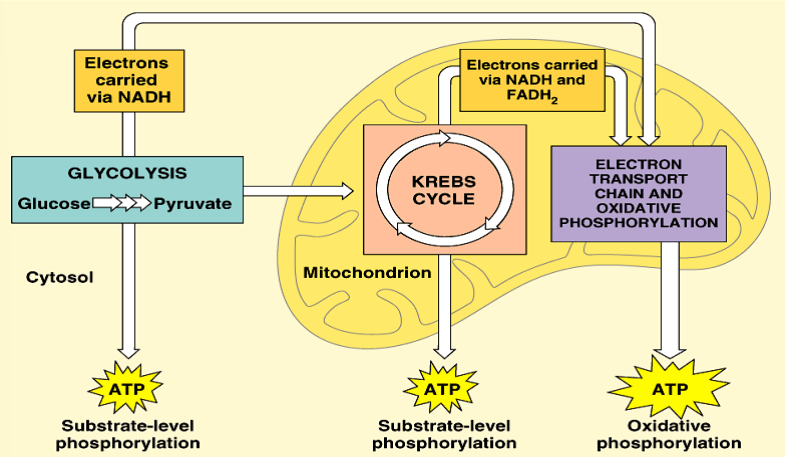
substrate-level phosphorylation
oxidative phosphorylation (ETS)
What are the 2 ways to make ATP?
Glycolysis: 2 ATP
Kreb's cycle: 2 ATP
What is ATP accounting of each cycle?
Glycolysis: ?
Kreb's cycle: ?
ETS (Electron transport system)
Series of molecules in mitochondrion (inner membrane)
32 ATP from 1 glucose
ETS yields to how many ATP molecules?
Aerobic
is ETC aerobic or anaerobic?
Double membrane
outer membrane
inner membrane
- highly folded cristae
- fluid-filled space between membranes = intermembrane spacematrix
Parts of Mitochondria
inner membrane
highly folded cristae
fluid-filled space between membranes = intermembrane space
matrix
It is the central fluid-filled space and form
4
How many complexes or parts in ETS?
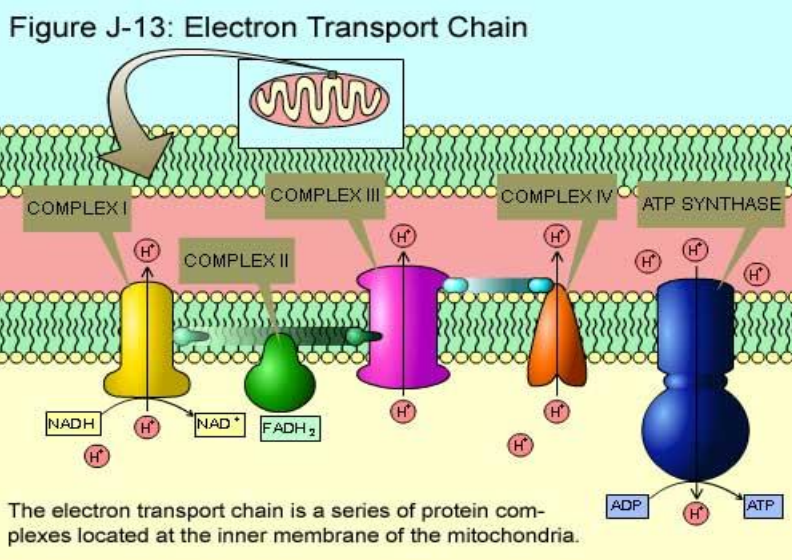
COMPLEX I – NADH dehydrogenase
COMPLEX II – Succinate dehydrogenase
COMPLEX III – Cytochrome bc1 complex
COMPLEX IV – Cyctochrome c oxidase and Ubiquinone
What are the different parts of ETS?
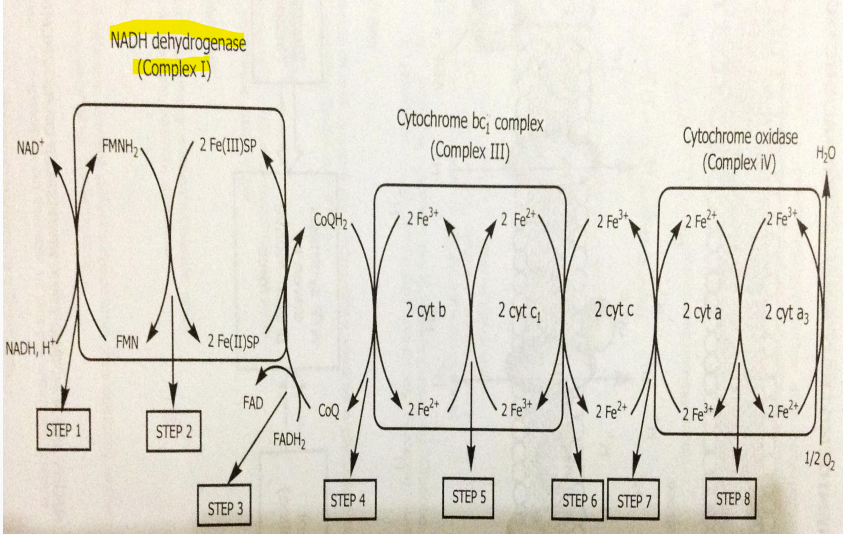
NADH dehydrogenase
What is COMPLEX I
Succinate dehydrogenase
What is COMPLEX II

Cytochrome bc1 complex
What is COMPLEX III

Cyctochrome c oxidase
COMPLEX IV
Ubiquinone
Mobile part of ETS that traverses the inner mitochondrion membrane
Complex I
NADH dehydrogenase
What complex accepts e- from NADH?
Complex II
Succinate dehydrogenase
What complex accepts e- from FADH2?

I > III > IV
Path of e- from NADH
II > III > IV
Path of e- from FADH
Ubiquinone, CoQ
This carries e- from:
I => III
or
II => III
Cyt C
Carries e- from III → IV
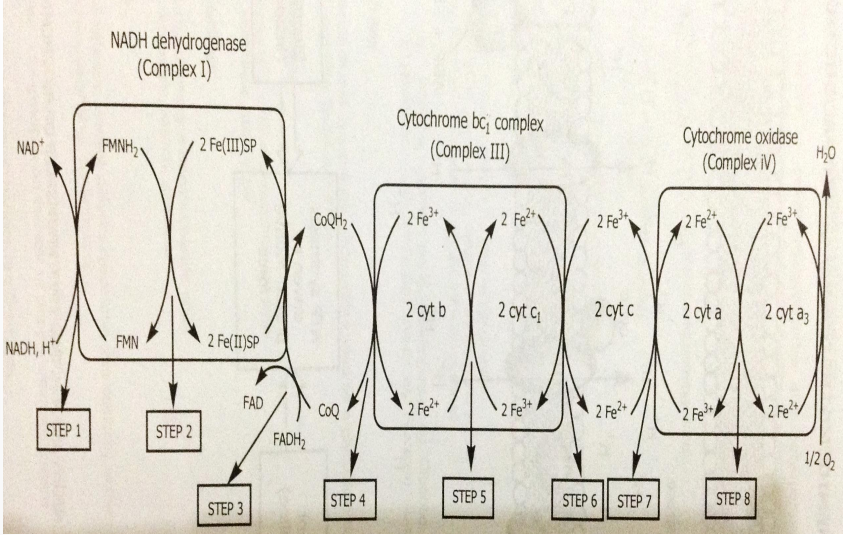
Occurs at: Cplx I
NADH reacts with FMN resulting in NAD+ and FMNH2
What is the Step 1?
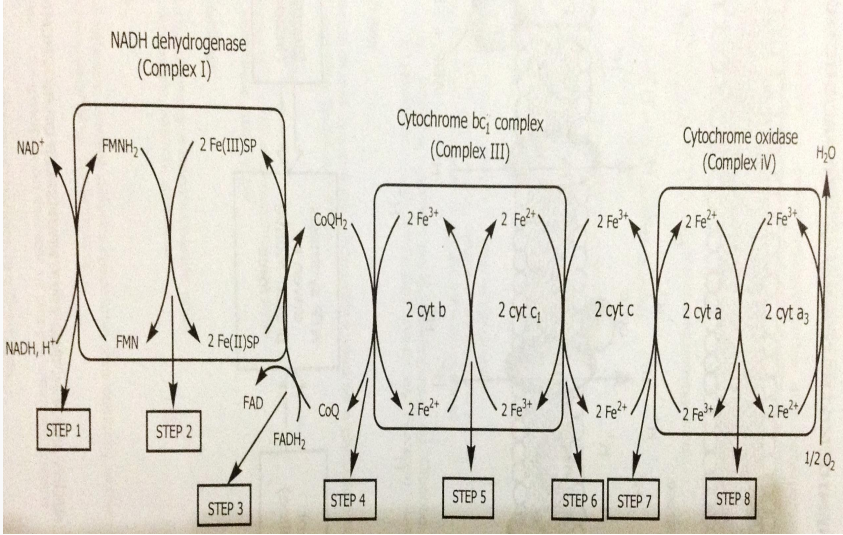
Occurs at: Cplx I
FMNH2 reacts with 2 Fe(III)SP resulting in 2 Fe(II)SP and FMN
FMN → Step 1
2 Fe(II)SP → 3
What is the Step 2?
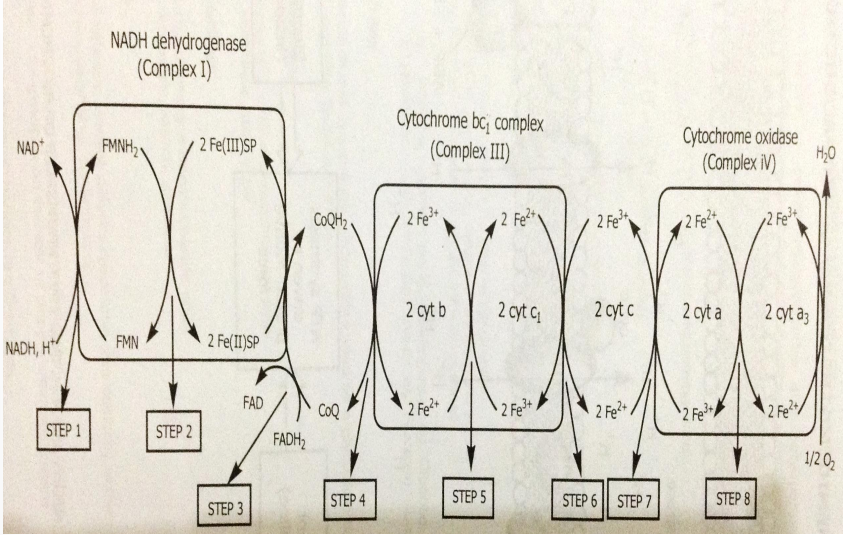
Occurs at: Inner membrane space
Transfer of e- to CoQ
2 Fe(III)SP transfers e- and H+ to CoQ, yielding:
2 Fe(II)SP => Step 1
CoQH2 => Step 4
OR
FADH2 transfers electron and 2H to CoQ, yielding:
FAD
CoQH2 → Step 4
Step 3

Occurs at: Cplx III boundary
Coenzyme/e- carrier: 2 cyt b
CoQH2 transfers e- to 2 Fe3+
Yields:
CoQ → Step 3
2 Fe2+ → Step 5
Step 4

Occurs at: Cplx III
Coenzyme/e- carrier: 2 cyt c1
2Fe2+ transfers e- to 2 Fe3+
Yields:
2 Fe3+ → Step 4
2 Fe2+ → Step 6
Step 5
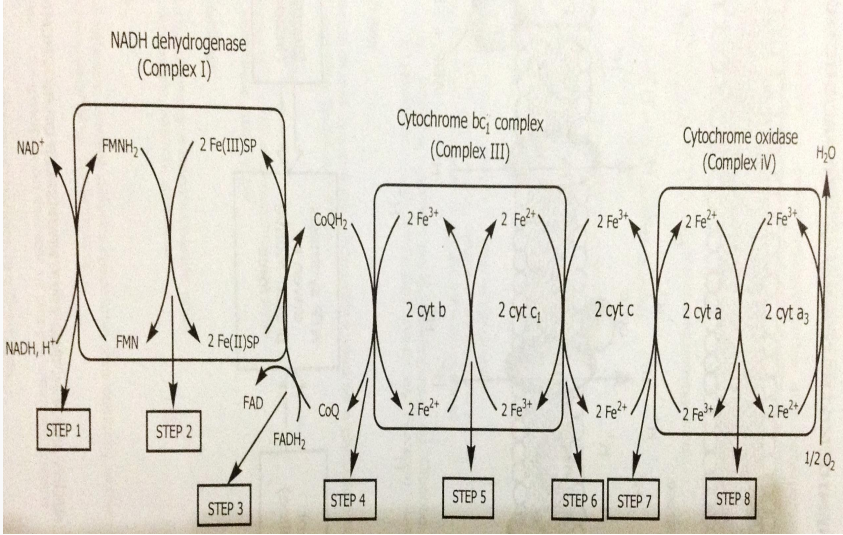
Occurs at: Cplx III boundary
Coenzyme/e- carrier: 2 cyt c
2Fe2+ transfers e- to 2 Fe3+
Yields:
2 Fe3+ → Step 5
2 Fe2+ → Step 7
Step 6
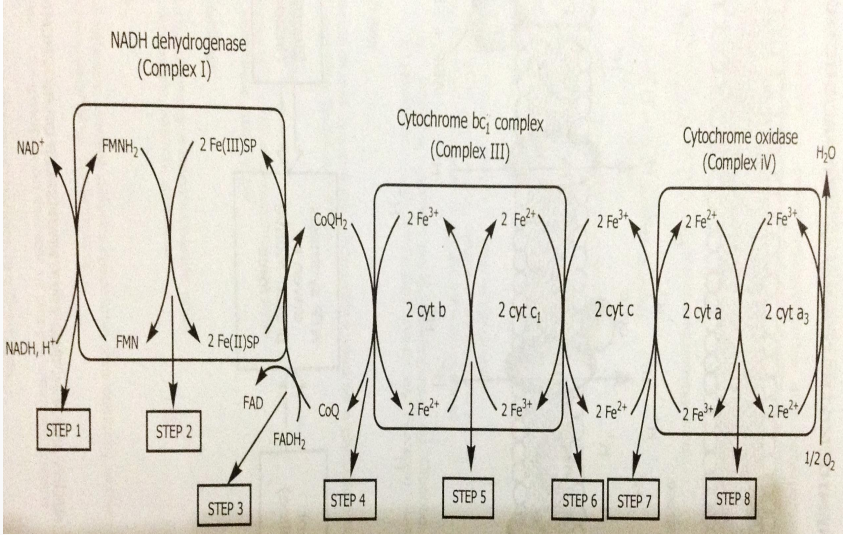
Occurs at: Cplx IV boundary
Coenzyme/e- carrier: 2 cyt a
2Fe2+ transfers e- to 2 Fe3+
Yields:
2 Fe3+ → Step 6
2 Fe2+ → Step 8
Step 7
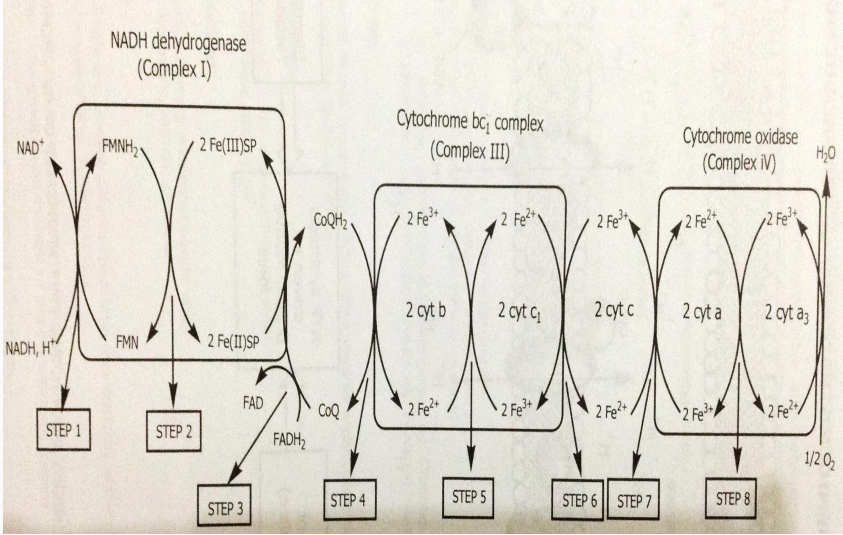
Occurs at: Cplx IV
Coenzyme/e- carrier: 2 cyt aa3
2Fe2+ transfers e- to 2 Fe3+
Yields:
2 Fe3+ → Step 7
And:
2 Fe2+ → 1/2 O2 (Last e- acceptor)
Yielding:
2 Fe3+ (Step 8)
H2O (end)
Step 9
1/2 O2
Last electron acceptor at IV
Prevents bulk release of energy that can result in high T
Why is the ETS divided into steps?
Chemiosmotic Theory
What drives ATP synthesis?
Peter Mitchell
Who proposed the Chemiosmotic Theory?
Electrical potential
pH gradient
2 requirements of ATP synthesis according to Peter Mitchell:
ATP synthase
enzyme in inner membrane of mitochondria
ADP + Pi => ATP
ATP synthase
It is the only channel permeable to H+
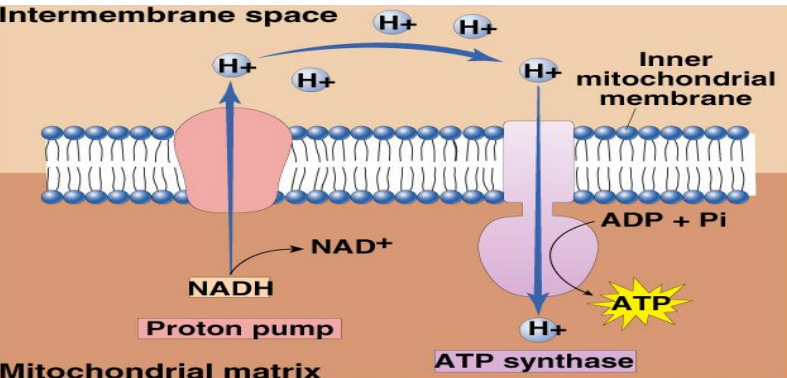
Chemiosmosis couples ETC to _________________
Build up of H+ gradient just so H+ could flow through ATP synthase enzyme to build ATP
ATP synthesis
Open - ADP and inorganic phosphate attach
Loose - Start to react
Tight - ATP production
Open - ATP is released and new ADP and Pi attach
(Repeat)
Conformations of ATP Synthase
C6H12O6 + 6O2 => 6CO2 + 6H2O + ~36 ATP
Summary of cellular respiration
Food
Where did the glucose come from?
Inhaled
Where did the O2 come from?
ETC backs up
ATP production ceases
cells run out of energy
and you die!
So what happens if O2 unavailable?
Kreb cycle
Where did the CO2 come from?
ETS
Where did the H2O come from?
Majority from ETS
Where did the ATP come from?
We need O2 in ETS
Why do we breathe?
Most mitochondrial reactions are said to be tightly coupled.
That is there is no electron flow without phosphorylation and no phosphorylation without electron flow.
For example, in the absence of ADP or O2 electron flow stops, reduced substrate is not consumed and no ATP is made.
ETS Control (3)
Punches hole at inner mitochondrial membrane, decreases H+ gradient => no ATP production
2,4 Dinitrophenol (DNP)
Valinomycin
Thermogenin
Defn and 3 examples of uncouplers
Valinomycin
Releases K+ to the matrix, makes matrix more positive and decreases electric gradient
Blocking
Directly blocks the flow of H+ through the Fo, directly inihibiting OP
Antibiotic oligomycin
Example of blocker
Antibiotic oligomycin
It blocks the flow of H+ through the Fo , directly inhibiting OP.
Redox Inhibitors
stops transfer of electrons
rotenone, amytal
Redox Inhibitors
block e- from NADH to CoQ
antimycin A
blocks cyt b => cyt c1
HCN, CO
block at cyt aa3 => O2
Brown adipose (fat) cells
Contain natural uncouplers to warm animals - cold adaptation and hibernation.
Thermogenin
natural uncouplers
Energy from redox reactions at ETS is released as heat
No ATP production since it is not needed
How uncouplers can be used to warm body